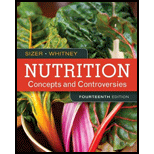
Nutrition: Concepts and Controversies - Standalone book (MindTap Course List)
14th Edition
ISBN: 9781305627994
Author: Frances Sizer, Ellie Whitney
Publisher: Brooks Cole
expand_more
expand_more
format_list_bulleted
Question
Chapter 2, Problem 17SC
Summary Introduction
To determine:
Whether the focus of consumers should be on the consumption of eating a wide variety of foods instead of searching for a specific phytochemical.
Introduction:
Phytochemicals are chemical compounds produced by plants. They are present in fruits, nuts, legumes, vegetables, and grains.
Expert Solution & Answer
Want to see the full answer?
Check out a sample textbook solution
Chapter 2 Solutions
Nutrition: Concepts and Controversies - Standalone book (MindTap Course List)
Knowledge Booster
Similar questions
- Nitrogen deficiency stunts plant growth and causes leaves to turn yellow and then die. Why does nitrogen deficiency cause these symptoms? Hint: Think about which biological molecules incorporate nitrogen atoms.arrow_forwardWhich is the better choiceto eat processed foods that have been enhanced with phytochemicals or to eat natural foods that are rich in phytochemicals?arrow_forwardCarbon, hydrogen, and oxygen are _______ for plants. a. macronutrientsd b. micronutrientse c. trace elements d. required elements e. both a and b f. both a and darrow_forward
- The movement of mineral nutrients through organisms and their environment is called a __________cycle. biological bioaccumulation biogeochemical biochemicalarrow_forwardFor an element to be regarded as essential, all of the following criteria must be met, except: No other element can perform the function The element is directly involved in plant nutrition The element is inorganic The plant cannot complete its lifecycle without the element.arrow_forwardWhich factors affect soil quality? chemical composition history of the soil presence of living organisms and topography cl. all of the abovearrow_forward
arrow_back_ios
arrow_forward_ios
Recommended textbooks for you
 Nutrition: Concepts and Controversies - Standalo...Health & NutritionISBN:9781305627994Author:Frances Sizer, Ellie WhitneyPublisher:Brooks Cole
Nutrition: Concepts and Controversies - Standalo...Health & NutritionISBN:9781305627994Author:Frances Sizer, Ellie WhitneyPublisher:Brooks Cole Biology: The Dynamic Science (MindTap Course List)BiologyISBN:9781305389892Author:Peter J. Russell, Paul E. Hertz, Beverly McMillanPublisher:Cengage Learning
Biology: The Dynamic Science (MindTap Course List)BiologyISBN:9781305389892Author:Peter J. Russell, Paul E. Hertz, Beverly McMillanPublisher:Cengage Learning Biology: The Unity and Diversity of Life (MindTap...BiologyISBN:9781337408332Author:Cecie Starr, Ralph Taggart, Christine Evers, Lisa StarrPublisher:Cengage Learning
Biology: The Unity and Diversity of Life (MindTap...BiologyISBN:9781337408332Author:Cecie Starr, Ralph Taggart, Christine Evers, Lisa StarrPublisher:Cengage Learning


Nutrition: Concepts and Controversies - Standalo...
Health & Nutrition
ISBN:9781305627994
Author:Frances Sizer, Ellie Whitney
Publisher:Brooks Cole


Biology: The Dynamic Science (MindTap Course List)
Biology
ISBN:9781305389892
Author:Peter J. Russell, Paul E. Hertz, Beverly McMillan
Publisher:Cengage Learning


Biology: The Unity and Diversity of Life (MindTap...
Biology
ISBN:9781337408332
Author:Cecie Starr, Ralph Taggart, Christine Evers, Lisa Starr
Publisher:Cengage Learning